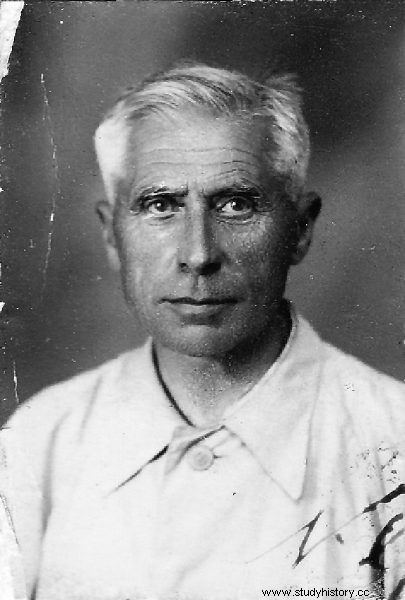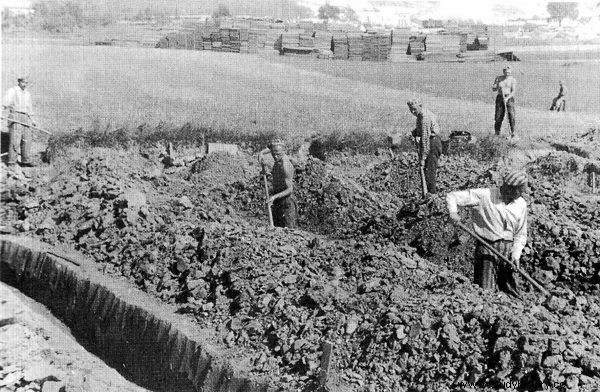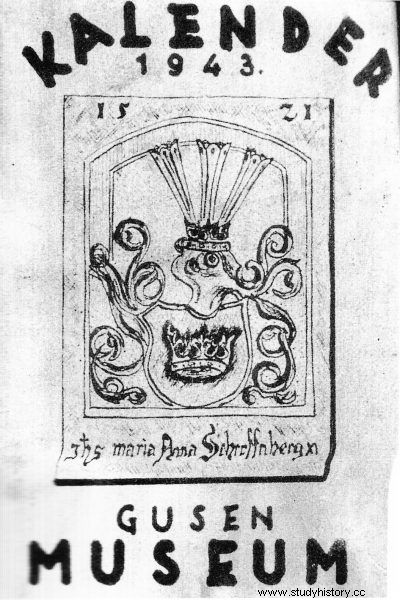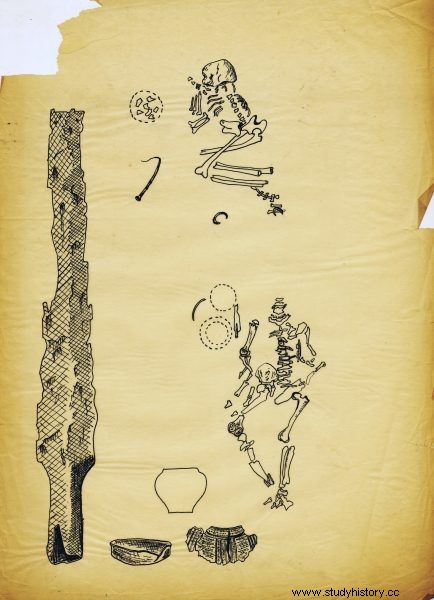strong> The Mauthausen-Gusen camp was one of the toughest Nazi camps. Its commanders prided themselves on the fact that hardly anyone lived there for six months. Kazimierz Gelinek came here as early as 1940 and lived 5 years straight out of a horror movie. Archeology allowed him to save his own life and the life of many of his fellow prisoners.
The Ordinary Beginnings of an Extraordinary Man
Kazimierz Gelinek was born on August 23, 1882 in Brzeżany (now western Ukraine). He lost his father shortly after. Kazimierz was a sickly child, and yet he served in the 7th Uhlan Regiment, which was stationed near Vienna. From the savings made at that time, he paid for school and graduated from high school and passed his high school diploma.
Unfortunately, his mother died shortly before the secondary school-leaving examination. He was offered a job as a railroad clerk, but he , driven by a passion for learning and dreams of education, took a job as a teacher . In August 1916, he was appointed inspector and was commissioned to open schools in Zamość and the entire Lublin poviat. He gladly set to work, starting with the education and preparation of 16 female teachers, and then began conducting courses and conferences for a total of 100 teachers and teachers. This initiative was a success.
Working as a teacher awakened Gelink's love of nature. As a result, in 1922 he enrolled in studies at the geography division at the Institute of prof. Ludomir Sawicki in Krakow, and then after 2 years he moved to Vilnius, where he obtained a teacher's diploma in general secondary schools and teacher training seminars.
He could easily accept many job offers, but Kazimierz Gelinek made his place of employment dependent on the natural conditions around him. He started working as a teacher in Płock, as well as cooperating with the Museum and the Scientific Society of Płock. It was during this period of his life that he began to explore the secrets of archeology. His research made it possible to formulate theses that greatly contributed to the knowledge of the history of Poland in the Neolithic. .
They came from the west
In 1939, Kazimierz Gelinek was repeatedly persuaded to sign the Volksliste, but these requests were repeatedly refused. In the same year, German soldiers burst into the museum and began to rob the museums there. Gelinek loudly protested and for this was accused of insulting the uniform of a German soldier .
On April 9, 1940, at five o'clock in the morning, Kazimierz Gelinek was arrested and transported to the concentration camp in Działdowo. Then he was transferred to KL Dachau, and finally to the Mauthausen-Gusen camp in Upper Austria. It was the first concentration camp created outside the Third Reich and it is widely believed that it belonged to the heaviest . For comparison, the prisoners from KL Auschwitz-Birkenau transported here died extremely quickly, and those who survived at least a little longer recalled their previous prison with sentiment and almost yearning. In 1940, 97% of the prisoners in the Gusen sub-camp came from Poland, and the aim of the unit was, inter alia, destroying Polish intelligentsia .
Almost immediately Kazimierz Gelink was assigned to work in quarries, and with time he was transferred to earthworks for the construction of the railway. Gelinek and Dr. Józef Iwiński independently then came across two valuable archaeological sites . It was Kazimierz Gelinek who persuaded the camp authorities to report this fact to the Institute for Monument Protection.

Kazimierz Gelinek was appointed to conduct excavation research in the area of KL Mauthausen-Gusen
Archaeologists stepped out
Over time, archaeologists were searched for at prison assemblies. It is not difficult to imagine that none of the prisoners wanted to lean out. In concentration camps, if someone was called out at a roll call, it usually meant one thing for him - death. However, it was soon made clear that it was about conducting research in the camp, and with this information several volunteers were collected.
The decision to start rescue work in the camp was issued by the commandant of SS-Standartenführer Franz Ziereis. It is well known that research was an activity dynamically developed by the Nazis . To this end, the Ahnenerbe Institute was founded in 1935, chaired by Herman Wirth on the orders of Heinrich Himmler.
Archaeological research was used in propaganda, incl. as validation of the areas occupied by the Third Reich. Therefore, if the commandant of Ziereis could confirm the Germanic settlement in the territory of Austria, it would be easy to justify the incorporation of these areas into the borders of the Reich . Franz Ziereis could also win his private victory and impress his superior Heinrich Himmler.
The camp was visited by the director of the Institute for Monument Protection and the very next day Kazimierz Gelink was commissioned to conduct archaeological research in the ruins of the nearby Spielberg Castle. Assistant Hertha von Orel and a preparator Josef Vockenhuber were assigned to help him.

Archaeological research was carried out in the surrounding areas of the camp
Salvation Command
Soon after, on November 19, 1940, the so-called " Commando Spielberg was created ”Consisting of 30 prisoners who worked during the excavation works. The first team included 27 priests, who were soon transferred to another camp - KL Dachau. Over time, the number of prisoners taken for archaeological excavations varied depending on the demand.
According to the accounts of witnesses, "Komando Spielberg" has become a very important element of everyday prison life. Kazimierz Gelinek always tried to select the most weak and depressed people to work in the ruins . In the ruins of the castle, on the sidelines of the tragedy that was their everyday life at that time, such people gained both physical and mental strength to fight for life and humanity.

"Komando Spielberg" kept calendars with drawings of monuments
In the conspiracy castle, a Gusen organization was created, headed by Władysław Gębik, Kazimierz Gelinek and a teacher from Bielsko, whose name, unfortunately, we do not know. The organization's purpose was to rescue the most exhausted prisoners and to bring them help and a moment of respite from the murderous work in the camp. The average life in this one of the heaviest concentration camps was 3 months. But this is not the end. Activities aimed at spreading culture among prisoners were also carried out, prison poetry was created, and even plans were made for life in liberated Poland.
Władysław Wnuk was one of the prisoners who devoted themselves to art in such cruel times. He wrote:
We are like living stones thrown into a bottomless abyss,
in which a dream burns, that the mountain is made of fire.
And on us, like a rock, a magnificent edifice will be created.
Like a bright lightning in the dark, like an eternal monument to glory.
Museum hut
Shortly after the first discoveries were made, Kazimierz Gelinek received orders to create a camp museum, where the materials obtained during the archaeological works were then exhibited and processed. One of the prison barracks was allocated for this purpose.
The work was moving forward and met the expectations of the Nazis, which is why, just before Christmas 1942, the commandant of KL Gusen Schutzhaftlagerführer Karl Chmielewski ordered the research team to prepare a monograph summarizing the work to date . The book was to be accurate and richly illustrated with drawings of monuments, enriched with topographic data, geological profiles and many other details.

The research was professionally documented on picture charts. In the photo, a plaque from the study "Excavations on the left bank of the Danube ..."
It was not an easy task, as there was also a date by which the monograph was to be ready. It fell on December 21 of the same year. Then the book was provided with an introduction by commandant Chmielewski and a preface by prof. Dr. Menghin. The goal was achieved and one of the five copies produced at that time was given to Himmler during his second visit to the camp .
Excavations were carried out until the camp was liberated by American troops on May 5, 1945. Another version of the monograph was written in the transit camp in February 1946 and it is a typescript of Kazimierz Gelink's memoirs entitled:"Excavations on the left bank of the Danube ...". Part of the collection, along with sketchbooks marked with the prison number Gelinka - 43041, was then taken to the Forschungsabteilung beim Kaastroche battallion, Pottenstein Oberfranken Station:Behringermühle über Nürnberg Foochheim.
The worst was behind him
What was the fate of Kazimierz Gelinek after the war? One would like to believe that a person of this caliber, after surviving five years in one of the worst concentration camps of the Third Reich, will return home as a hero and find peace among his family. But Gelink was not allowed to experience this luxury . After leaving the camp, he weighed only 34 kg, he was exhausted from health, and when he returned to his beloved Płock, he discovered that he had lost his wife and daughter, all his belongings and work.
He had nowhere to live. He slept on the street or to get friends, until he finally managed to find a job in a technical school (the so-called Vocational Training Center). Gelinek recalled that the winter of 1946/47 was so cold that the water in the glass froze at school. From September 1956 until his retirement, he accepted a teaching position at the General Secondary School for Working.
Kazimierz Gelinek spent 5 years in the Nazi concentration camp of Mauthausen-Gusen. Thanks to his skills and archeology, he managed not only to survive, but also to save many of his fellow prisoners . In these difficult and cruel circumstances, he maintained not only humanity, but also professionalism. His rescue research was extremely thorough. He was an archaeologist, museologist and scientist .
Surprisingly, his work, although it was handed over to prof. Józef Kostrzewski, it has not been published. To this day, we do not know why. Prof. On the one hand, Kostrzewski could be critical of this type of activity, and on the other hand, he could protect Gelink from the consequences that such a publication could provoke from the authorities of the time.
The materials from the camp excavations were re-edited in the "Archeology of Austria" yearbook, however, the editors of the year and the authors of other studies relating to the Mauthausen-Gusen camp almost completely omit Kazimierz Gelink and his companions, except for one . The yearbook as the initiator of the research was presented by Dr. Johann Gruber - a Catholic priest from Linz, who joined the Gelinka team in 1942 and performed administrative functions (Dr. Gruber was an extremely noble and meritorious person for Austria).
